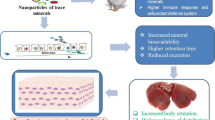Abstract
Two experiments were conducted in which varying levels of lead (up to 2000 ppm as lead acetate trihydrate) and selenium (up to 40 ppm as Na2SeO3) were fed, either alone or in combination, to chicks from day-old through 18 or 20 d. Lead additions depressed growth in a dose-dependent manner without affecting mortality. Selenium addition at 20 ppm was severely growth inhibitory, but mortality was not affected. The growth inhibition of 20 ppm Se was partially alleviated by feeding it in combination with 2000 ppm Pb; however, mortality was increased significantly by the combination. In contrast 40 ppm Se resulted in almost complete cessation of growth and 85% mortality, whereas the combination with 2000 ppm Pb partially overcame the growth inhibition and eliminated the excess mortality. When Pb or Se were fed alone, hepatic levels of the fed element were elevated. There were further significant elevations of hepatic levels of both elements when fed in combination at identical dietary concentrations as the single element additions.
The results suggest that Pb and Se are antagonistic. The nature of the interaction of these elements is such that although 2000 ppm Pb partially overcomes the growth inhibition by 20 or 40 pm Se, the reverse (relief of Pb inhibition by Se) is not observed.
Similar content being viewed by others
References
A. L. Moxon,Science 88, 81 (1938).
A. W. Halverson and K. J. Monty,J. Nutr. 70, 100 (1960).
J. Parizek, I. Ostadalova, J. Kalouskova, A. Babicky, L. Pavlik, and B. Bibr,J. Reprod. Fertil. 25, 157 (1971).
H. E. Ganther, C. Goudie, M. L. Sunde, M. J. Kopecky, P. Wagner, S. H. Oh, and W. G. Hoekstra,Science 175, 1122 (1972).
C. H. Hill,J. Nutr. 104, 593 (1974).
G. O. Howell and C. H. Hill,Environ. Health Perspect. 25, 147 (1978).
W. E. Donaldson and T. K. Leeming,Toxicol. Appl. Pharmacol. 73, 119 (1984).
O. E. Olson, I. S. Palmer, and E. E. Cary,J. Assoc. Off. Anal. Chem. 58, 117 (1975).
SAS Institute,Statistical Analysis System User's Guide, Cary, NC (1979).
A. H. Cantor, M. L. Scott, and T. Noguchi,J. Nutr. 105, 96 (1975).
D. M. Latta and W. E. Donaldson,J. Nutr. 116, 1561 (1986).
H. L. Klug, G. P. Lampson, and A. L. Moxon,Proc. SD Acad. Sci. 29, 57 (1950).
J. Parizek, I. Ostadalova, J. Kaluskova, A. Babicky, L. Pavlik, and B. Bibr,Physiol. Bohemoslov. 18, 95 (1969).
C. H. Hill,Fed. Proc. 34, 2096 (1975).
Author information
Authors and Affiliations
Rights and permissions
About this article
Cite this article
Donaldson, W.E., McGowan, C. Lead toxicity in chickens. Biol Trace Elem Res 20, 127–133 (1989). https://doi.org/10.1007/BF02919105
Received:
Accepted:
Issue Date:
DOI: https://doi.org/10.1007/BF02919105




